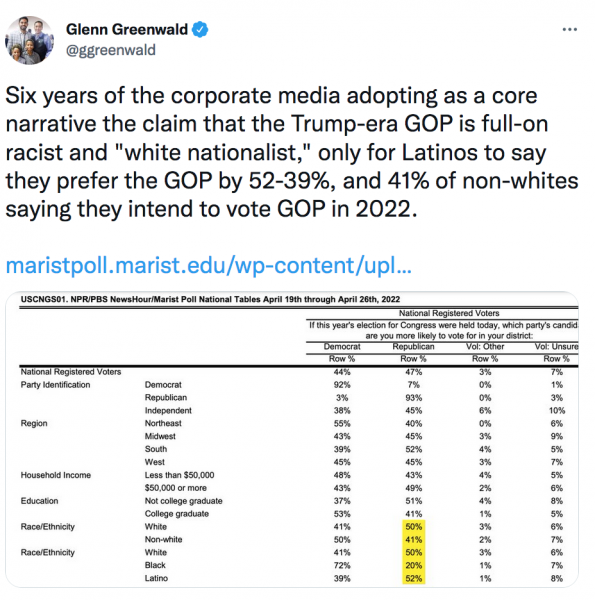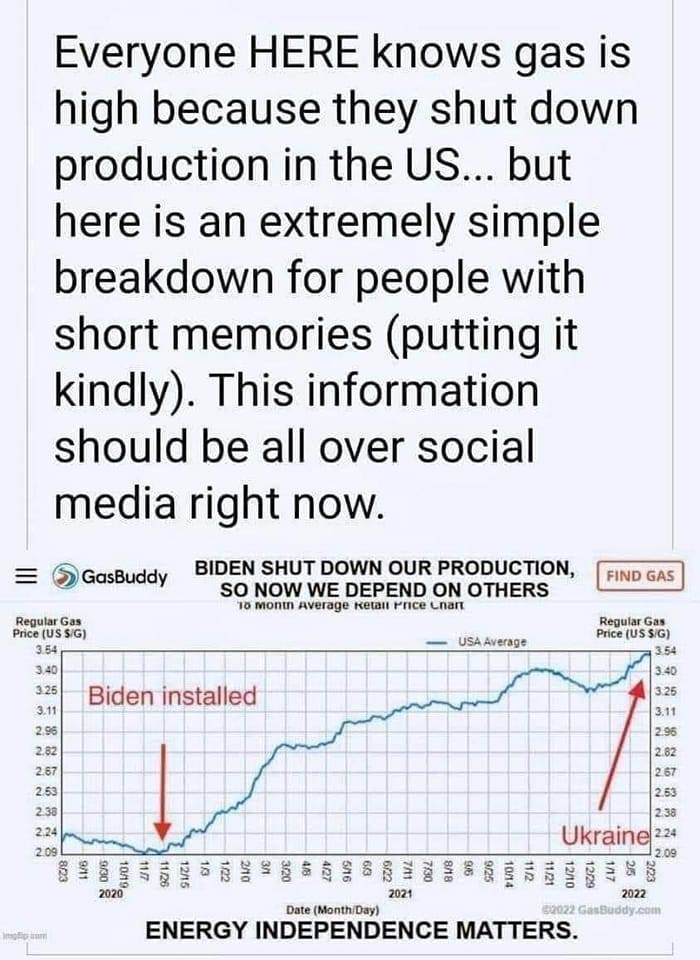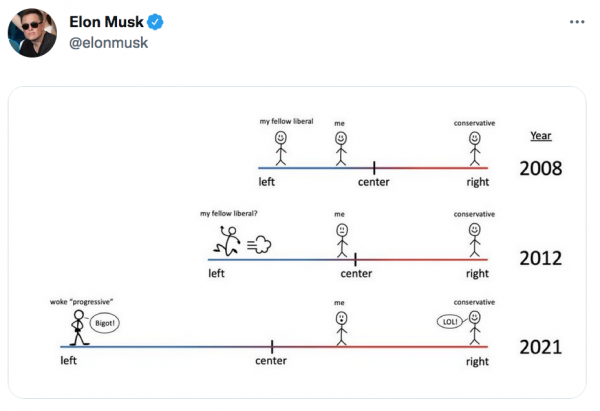…is being waged by the left, and it’s on the very word “woman” and “women” and on the concept itself.
The left has supported transgender political and cultural activism to such a great extent that not only are biological men such as Lia Thomas allowed to enter women’s sports and compete there by claiming to be women, but the word “woman” itself has undergone a transformation for health professionals, who are now discouraged from using it.
Certainly it’s good for medical professionals to be aware that a person who looks like a man or a woman may have biological organs that don’t match his or her outward presentation and that it can be medically important to consider that possibility at times. But that’s a far far cry from eliminating the basic concepts of men and women and surrendering to the reduction of people to their genitalia.
Archive for 2022
May 1, 2022
DISPATCHES FROM NERD PROM: Joe Biden Laughs at America’s Economic Struggles. “‘I’ll be honest. If you didn’t come I totally would’ve understood,’ [Trevor] Noah told Biden. ‘Because these people have been so hard on you, which I don’t get. I really don’t. You know, I think ever since you’ve come into office, things are really looking up. Gas is up. Rent is up. Food is up. Everything.’ And Joe Biden laughed.”
There’s a powerful campaign commercial here, if GOP video makers are paying attention.
READER FAVORITE: SparkPod Shower Head. #CommissionEarned
THEY LIE TO DIVIDE PEOPLE:

HIGHER EDUCATION BUBBLE UPDATE: Texas will study how to support college degree alternatives.
IT WAS LITERALLY DESIGNED FOR THAT SPECIFIC PURPOSE: ‘Critical Race Theory’ is incompatible with freedom of speech or equal treatment.
THIS ISN’T ENHANCING THE AAA’S CREDIBILITY ON GAS PRICES: “There are very few weapons in the president’s arsenal they can use, and he’s pretty much trying everything.”
Is he? Is he really?

Related: Biden tormented by Republican guerrilla campaign and ‘I did it’ stickers.
Also: 100Pcs I Did That Biden Funny Car Stickers. #Resist #CommissionEarned
DEAL OF THE DAY: Slim Leather Wallet. #CommissionEarned
THE ELITES ARE STUPID, EVIL, AND OBSESSED WITH RACE:
But the elites have decided otherwise. https://t.co/9MWCuloj0G
— Andrew Sullivan (@sullydish) April 28, 2022
UPDATE: So this embed previously included a tweet from Zaid Jilani showing that Americans think race, ethnicity, and gender are the least important factors for college admission. Jilani now appears to have deleted the tweet and gone on a “vacation” from social media, I guess because of all the lefty blowback. Proving the point. . .
RIGGED: Jones Day Finds USC Dean Intentionally Reported False Data To U.S. News To Goose Its Ranking. “The former dean of the University of Southern California’s education school directed administrators to omit information from its U.S. News & World Report rankings submission to boost the school’s placement at least as far back as 2013, according to an investigation released Friday by the university.”
April 30, 2022
OPEN THREAD: We must either love each other, or we must die. Flying high.
IT’S JUST WATER WEIGHT, GUYS: Physicists Just Measured The Heaviest Known Particle With Record-Breaking Precision.
THE COUNTLESS FAILURES OF BUREAUCRACY: Doesn’t matter if the bureaucracy is in the military or Department of Defense civilian workforce, or anywhere else in the sprawling, out-of-control, unaccountable federal bureaucracy.
Don Devine, who ran the Office of Personnel Management (OPM) during the Reagan era, knows a thing or three about bureaucracy and, in a post on the American Spectator, offers examples from the Pentagon that ought to scare the crap out of every one of us.
FULL DISCLOSURE: I was a Reagan appointee, serving for three years under Devine as Assistant Director of OPM for Public Affairs.
THIS SEEMS BELIEVABLE: Brains shift in adolescence to tune out parents’ voices.
Some items end up on the agenda because a towering majority of Americans demand change—the most obvious recent example is rising gas prices. Student debt feels different. After all, just 13 percent of the country carries federal student debt. Gallup frequently asks Americans what they believe is the most important problem facing the country today. According to the Gallup analyst Justin McCarthy, the pollster is unable “to report the percentage of Americans who have mentioned student debt or student debt cancellation because it hasn’t garnered enough mentions to do so.” In 2022 so far, he told me via email, Gallup has conducted four polls on the question and “just one respondent mentioned this as the most important problem facing the nation.”
Why, then, is student-debt cancellation having such a moment in the national political conversation? . . .
Reason five: The power of college graduates
According to Catalist data, roughly 43 percent of the 2020 Biden electorate graduated from a four-year college or university. Compare that with 2012, when, according to Pew, just 36 percent of registered Democrats had completed a four-year degree or more. Given that trend, student-loan forgiveness may seem like the classic tale of a political party transferring a valuable benefit to a crucial constituency.
Although college-educated voters are an important segment of the Democratic Party, no one identity group is completely dominant. The party has long been a coalitional organization stitched together loosely and lacking a clear ideological core. Daniel Schlozman, a political scientist at Johns Hopkins University, explained a coalitional shift within the party in recent years. “Democrats are becoming more consistently liberal in a variety of ways, and they’re becoming more upper-middle-class all at once,” he told me. “And that creates some awkwardness.”
Awkward indeed that so much energy has been spent on a policy proposal that would affect just 13 percent of the population, and that would send the most dollars to high-income earners and those with graduate degrees. The fervor with which student-loan advocates argue that these policies are in fact racially and economically progressive may be an attempt to resolve the awkwardness that Schlozman describes—advocates of debt cancellation are trying to build a coherent narrative for why a diverse coalition, many of whom have never attended college, should be in favor of forgiveness.
College-educated voters are not just dominant within the Democratic Party; they also dominate the media and, naturally, academia—two institutions that have significant power over what issues are brought to the fore.
It benefits the ins at the expense of the outs for doctors and professors to have their loans paid off by truck drivers and manicurists.
NEWS YOU CAN USE: How to Find The Best Concealed Carry Holster.
READER FAVORITE: Garage Light – LED Garage Light 2 Pack. #Commissionearned
SOCIALIST “IT GIRL” CONTINUES TO PAY DIVIDENDS: Elon Musk Trolls AOC on Twitter and It’s the Best Thing Ever.
Related: Spotted: Socialist AOC’s Tesla Parked Illegally Outside Whole Foods in Posh DC Neighborhood.

